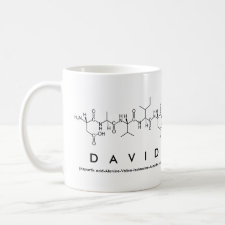
Authors: Simon R, Collins ME, Spivak DA
Article Title: Shape selectivity versus functional group pre-organization in molecularly imprinted polymers.
Publication date: 2007
Journal: Analytica Chimica Acta
Volume: 591
Issue: (1)
Page numbers: 7-16.
DOI: 10.1016/j.aca.2006.12.045
Alternative URL: http://www.sciencedirect.com/science/article/B6TF4-4MSPV55-4/2/1f59c8d005f4eb47ce38a6487a269c19
Abstract: A systematic survey of related molecular probes differing in shape or functional group orientation was used to compare the effects of shape selectivity versus pre-organization of functional monomers on imprinting and rebinding performance of molecularly imprinted polymers (MIPs). These studies revealed that templates with two functional group interactions with the MIPs are influenced to a larger degree by shape selective interactions than templates with three functional group interactions. For example, with two functional group interactions, increasing side chain size of compounds 1-5 increased selectivity 5-fold; while the same size change for compounds with three functional group interactions leads to a maximum 2-fold increase. Thus, the effects of shape selectivity and pre-organization of functional groups do not appear to work in concert with each other during the imprinting process or in the rebinding behavior. Furthermore, greater selectivity is generally found for templates with two functional groups, where the dominant mode of molecular recognition is shape selectivity. For example, the α value for the MIP elicited toward template compound 5 with two hydrogen bonding groups was 5-12-fold higher than equivalently shaped compounds 6-8 that have three non-covalent binding interactions (Table 3). On the other hand, pre-organization of functional groups dominated the performance of MIPs elicited toward templates with three template-functional group interactions. This is observed in Tables 6-8, where compounds with identical positioning of three functional groups all show less than an order of magnitude change in α values despite changes in shape
Template and target information: L-2-Amino-N-phenyl-propionamide, D-2-amino-N-phenyl-propionamide, L-2-Amino-N-pyridin-2-yl-propionamide, D-2-amino-N-pyridin-2-yl-propionamide, L-2-Amino-N-pyridin-3-yl-propionamide, D-2-amino-N-pyridin-3-yl-propionamide, L-2-Amino-N-pyridin-4-yl-propionamide, D-2-amino-N-pyridin-4-yl-propionamide, L-2-Amino-3-methyl-N-phenyl-butyramide, D-2-amino-3-methyl-N-phenyl-butyramide, L-2-Amino-3-methyl-N-pyridin-2-yl-butyramide, D-2-amino-3-methyl-N-pyridin-2-yl-butyramide, L-2-Amino-3-methyl-N-pyridin-3-yl-butyramide, D-2-amino-3-methyl-N-pyridin-3-yl-butyramide, L-2-Amino-3-methyl-N-pyridin-4-yl-butyramide, D-2-amino-3-methyl-N-pyridin-4-yl-butyramide, L-2-Amino-3,N-diphenyl-propionamide, D-2-amino-3,N-diphenyl-propionamide, L-2-Amino-3-phenyl-N-pyridin-2-yl-propionamide, D-2-amino-3-phenyl-N-pyridin-2-yl-propionamide, L-2-Amino-3-phenyl-N-pyridin-3-yl-propionamide, D-2-amino-3-phenyl-N-pyridin-3-yl-propionamide, L-2-Amino-3-phenyl-N-pyridin-4-yl-propionamide
Author keywords: Molecularly imprinted polymers, shape selectivity, Pre-organization, Structure-binding relationship, molecular recognition



Join the Society for Molecular Imprinting

New items RSS feed
Sign-up for e-mail updates:
Choose between receiving an occasional newsletter or more frequent e-mail alerts.
Click here to go to the sign-up page.
Is your name elemental or peptidic? Enter your name and find out by clicking either of the buttons below!
Other products you may like:
 MIPdatabase
MIPdatabase









